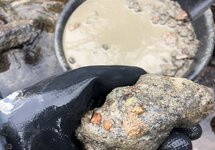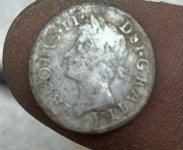Kuntzy
Jr. Member
I went out digging this past thursday. There was ice on the river, and the gravel bars were frozen down to around 6 inches. I wasn't able to classify any material at the river due to the temps so i just filled 20 unclassified buckets of material to bring home and work during the cold weather.
While digging i punched through two different clay layers. The first layer i hit was a mix of blue clay and smaller rock.it is a pretty soft clay. The second clay layer is around an inch thick and hard as a rock, there is some cobble on it but none on the inside of these huge clay chunks
If there is gold in any of this clay i want it. any tricks or tips to get the majority of the clay broken up enough to pan?
Thanks, Justin.
While digging i punched through two different clay layers. The first layer i hit was a mix of blue clay and smaller rock.it is a pretty soft clay. The second clay layer is around an inch thick and hard as a rock, there is some cobble on it but none on the inside of these huge clay chunks
If there is gold in any of this clay i want it. any tricks or tips to get the majority of the clay broken up enough to pan?
Thanks, Justin.
Amazon Forum Fav 👍
Upvote
0






